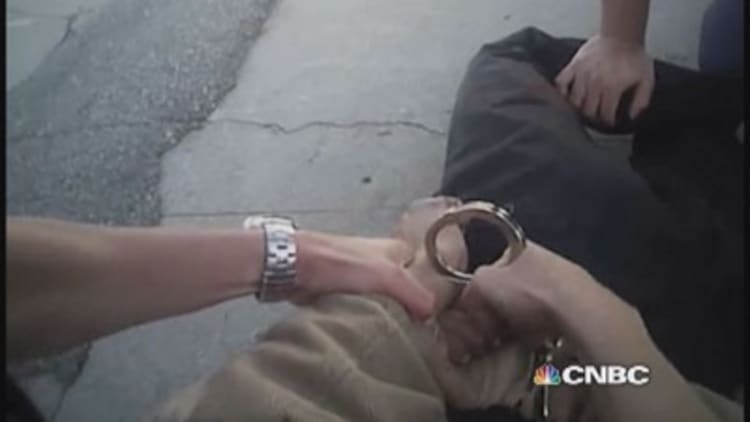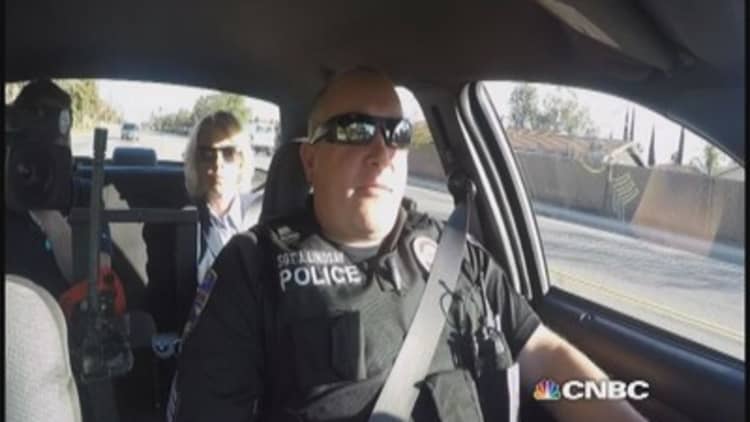
This week the Los Angeles Police Department announced it would spend millions of dollars to outfit all 7,000 patrol officers with body cameras, choosing a system from Taser.
The hope is that a camera system will help build trust and provide accountability for officers and the people they encounter. A camera system costs a lot of money, but it could potentially lower the number of complaints and use-of-force incidents, saving the city money on lawsuits.
But do cameras modify behavior? "Absolutely," said Sgt. Josh Lindsay of the Rialto Police Department. This city of 100,000 east of Los Angeles has been using the AXON system from Taser for three years.
Read MoreThe 'Waze Craze,' and why it upsets people in LA
"The whole experiment wasn't based on figuring out whether the camera was the right camera," said Rialto Police Chief Tony Farrar. "It was really more to evaluate the impact that the cameras would have on law enforcement."
In the first year the cameras were used, complaints dropped 80 percent, and use-of-force incidents fell by more than half, he said.
The Taser system uses a lipstick-sized camera, attached to either a shoulder, collar, hat or glasses. It is wired to a battery pack, and it syncs to an officer's smartphone to transmit a live picture of what the camera is seeing. The smartphone also allows the officer to add data to the video.
The cameras roll constantly for 30 seconds, and each 30 seconds is immediately replaced by the next 30 seconds until the officer actually taps a button to start recording. Usually that's done as he or she gets out of a squad car. Turning on the camera allows the officer to permanently capture the previous 30 seconds and then everything that follows, with audio.
At the end of the shift, an officer puts the camera and battery pack in a docking system, and all of the video from that shift is downloaded automatically onto Taser's Evidence.com software. There is no extra paperwork.
"We settled on Taser because the devices were better for patrol officers," said Farrar. He used grant money to pay for 54 cameras at a cost of $100,000. The Evidence.com software is an additional $80,000 a year.
Read MoreUS to embark on massive overhaul of Cuba relations
The system isn't perfect. The cameras only work if an officer hits the start button.
"If you deliberately don't use the device, then you're going to be held responsible for that," Farrar said.
Lindsay said, the "'I forgot' excuse really doesn't work anymore," though in the beginning, it took officers a while to remember to turn on the cameras.
"It's just like everything else now," Lindsay said. "You don't get out of your car without putting it in park, it's the same thing, we don't get out of our car without turning the camera on. It becomes muscle memory."
The clips stay in the system for as long as needed, and an audit trail of who "touches" the video is automatically generated. Only the chief or two supervising sergeants can delete a clip early, and if one of them tries to do that, the other two are immediately notified and can override that decision.
Has that ever happened? Once. A clip was deleted early when a police officer accidentally kept the camera rolling as he went to the bathroom.
Read MorePoll: 57% of Americans say race relations in US are bad
"One more pair of eyes doesn't bother me at all, because if you're doing the right thing, you shouldn't have to worry about that," said Lindsay.
He said that not only has the presence of a camera modified his behavior, but it's also modified the behavior of some people he encounters.
"I try to take that extra minute to make sure they understand what I'm talking about," he said. "The couple of people that I've mentioned it to and said, 'Just so you know, I'm recording everything,' even though they might be a little bit angry at the time, it seems like it's calmed them down just a little bit."
The cameras have proven durable enough to survive a fight that broke out between an officer and a suspect after Rialto got a call about a man who was acting violent. (Video of the incident is below.)

"We've had several instances where we've had officers exonerated," by the video, Farrar said.
And video has implicated officers as well.
"We've had one instance of discipline related to the video, and it was on video," Farrar said.
However, having the ability to turn off the camera can be important at times if witnesses wish to speak without being videotaped. Sometimes there are HIPAA considerations regarding videotaping injuries during a car wreck, he said. "Maybe there are times when you don't really want to have that thing turned on."

Up next, Chief Farrar said the local District Attorney's office will soon be able to tap into the system directly so that officers don't have to spend time downloading clips onto disks to deliver to prosecutors. Down the road, Sgt. Lindsay would like to see the cameras continue to get smaller and batteries last longer (they currently last for a full 12-hour shift).
"You're probably going to see live streaming video," said Farrar about the next wave of technology. "Video going back to the dispatch center or to the sergeant's computer or the sergeant's cellphone, where they're going to be able to monitor their employees and see what's happening live right as it's unfolding."
What do residents think? We spoke to a man pulled over for speeding by Sgt. Lindsay.
"It's better for everybody," he said. "Now on both sides of the of the party, there's video evidence, no more of 'he said, she said.' Now there's proof."
Yet for all the cameras do, everyone agrees they are a tool, not a solution.
"If you have a bad relationship with your community," Lindsay said, "a camera is not going to fix it."


